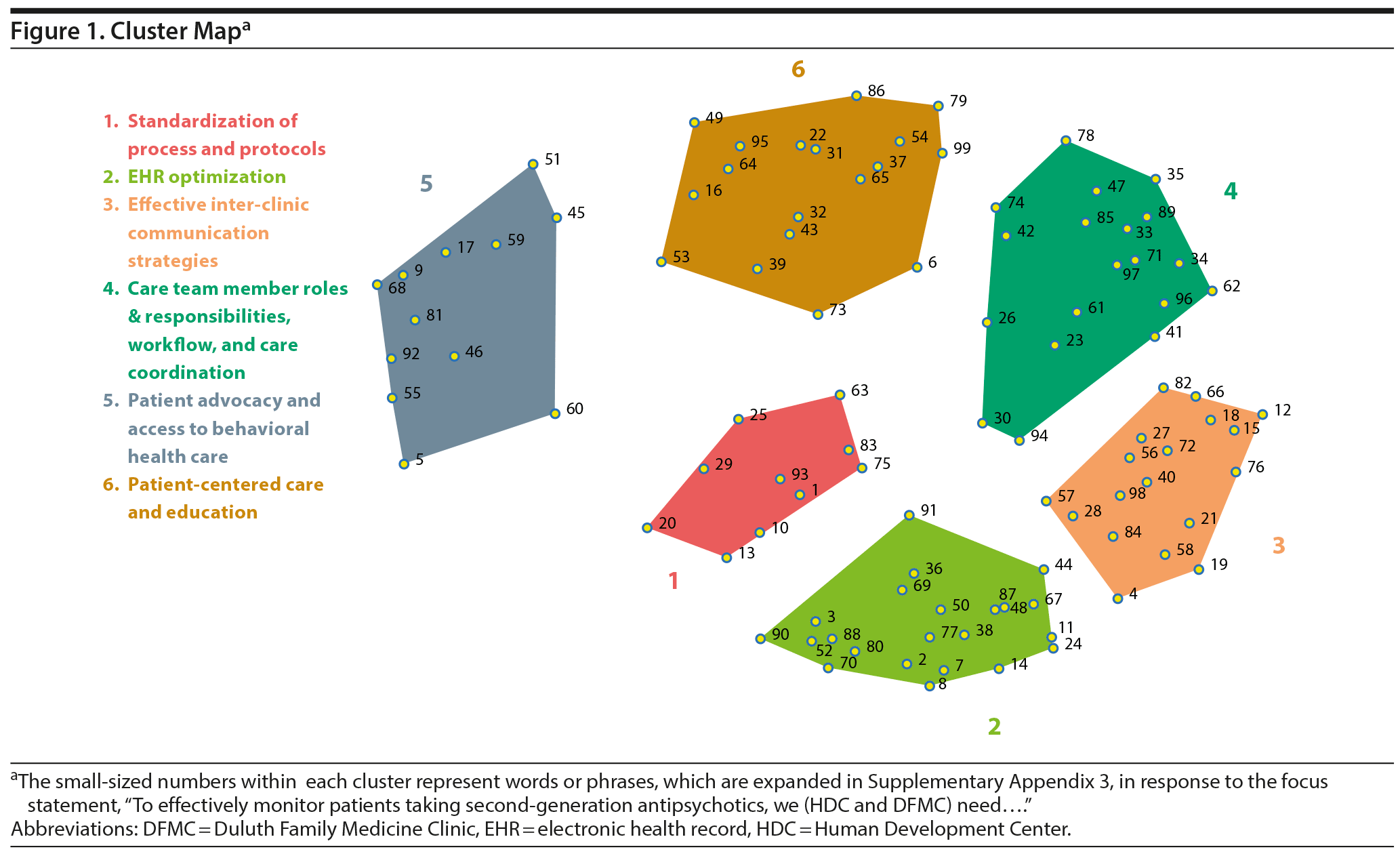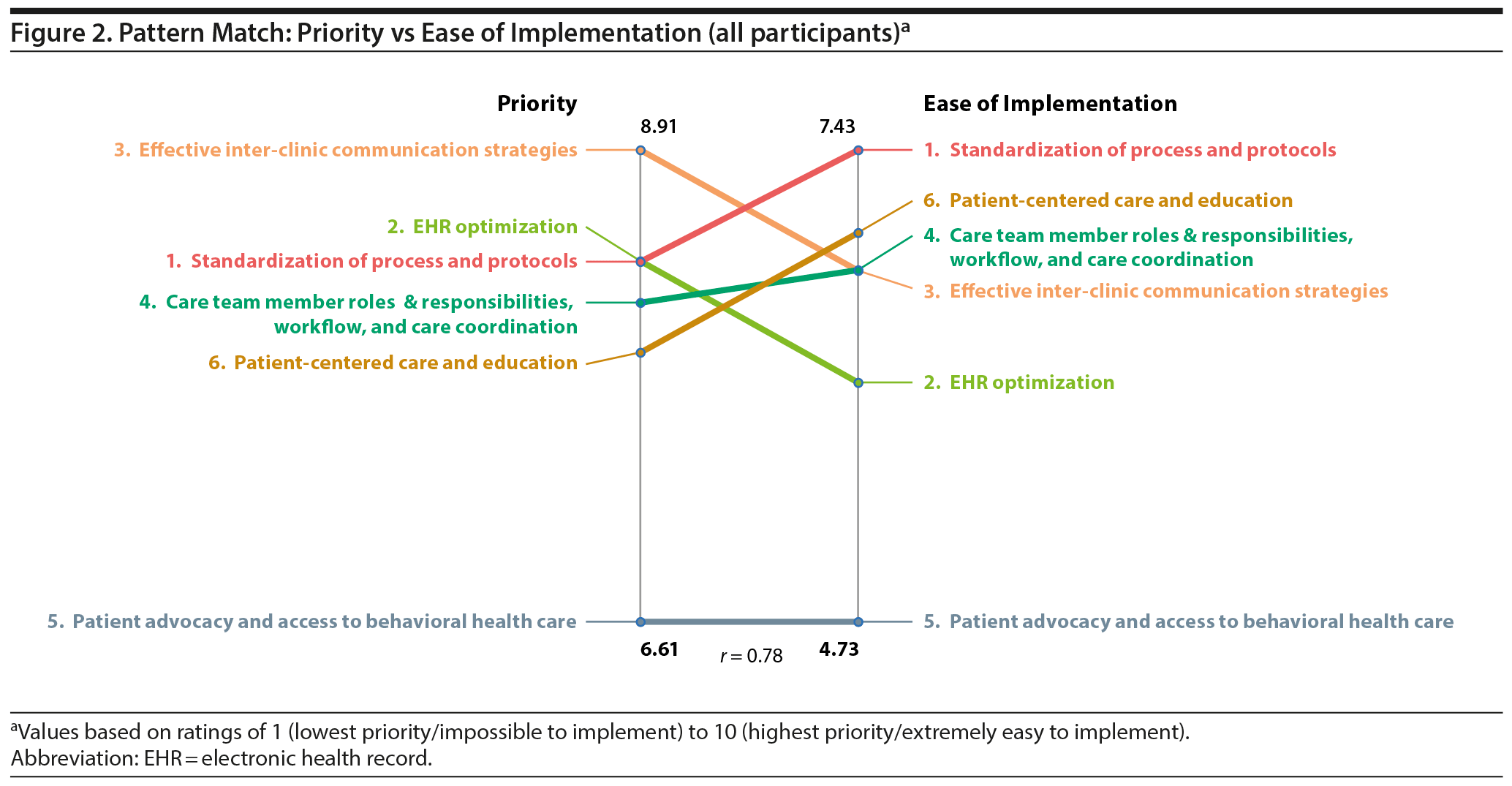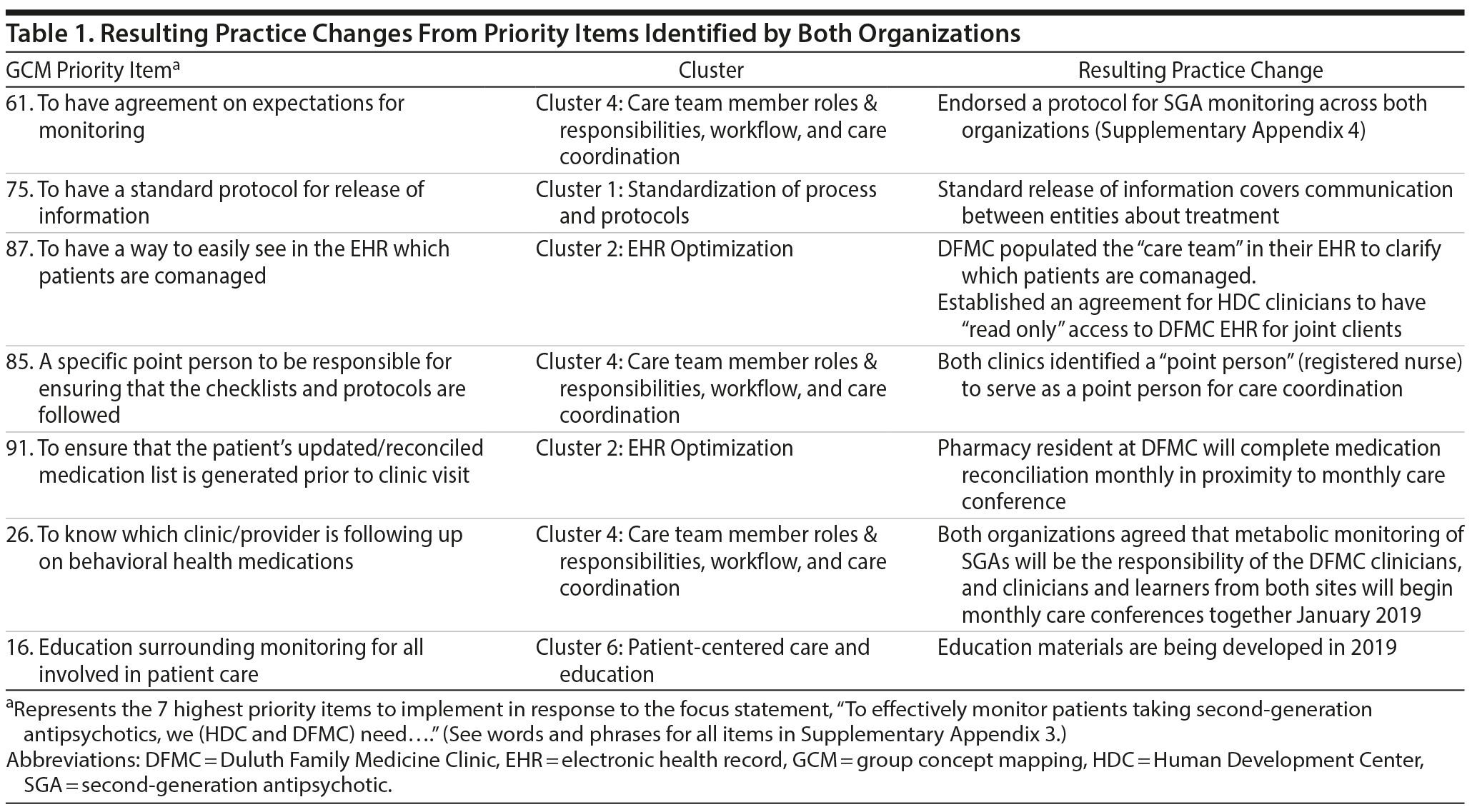Objective: Patients with severe mental illness often lack care coordination between primary care and mental health providers. Siloed patient care across separate health care systems can negatively impact quality and safety of patient care. The purpose of the project discussed in this article is to effectively engage stakeholders from separate primary care and mental health organizations to develop an ideal cross-organization communication system to improve metabolic monitoring for their comanaged patients prescribed second-generation antipsychotics (SGAs).
Methods: The mixed method approach of group concept mapping was used to engage stakeholders across a nonaffiliated primary care clinic and a community mental health organization over the time period of March 2018 through May 2018.
Results: Three important domains in communication were identified: (1) process/workflow, (2) advocacy, and (3) a patient-centered focus. Seven high priority/easier to implement brainstormed items were identified and resulted in practice changes across both organizations, including developing a standard release of information, identifying a point person from each clinic focused on cross-organization care coordination, endorsing an SGA monitoring protocol across organizations, agreeing that metabolic monitoring of SGAs will be the responsibility of the primary care clinicians, beginning monthly medication reconciliation and cross-organization care conferences, developing standard electronic health record documentation, and providing education.
Conclusions: Care coordination across all health systems is critical to optimize patient care for chronic medical and psychiatric conditions. Group concept mapping provides a strategic process to allow shared decision-making among stakeholders to take steps toward solving more complex systematic problems such as poor electronic health record interoperability across health systems.
CME Background
Articles are selected for credit designation based on an assessment of the educational needs of CME participants, with the purpose of providing readers with a curriculum of CME articles on a variety of topics throughout each volume. Activities are planned using a process that links identified needs with desired results.
To obtain credit, read the article, correctly answer the questions in the Posttest, and complete the Evaluation. A $10 processing fee will apply.
CME Objective
After studying this article, you should be able to:
• Take steps to improve coordination of medical and psychiatric care for patients with severe mental illness (eg, those taking second-generation antipsychotics who need metabolic monitoring)
Accreditation Statement
The CME Institute of Physicians Postgraduate Press, Inc., is accredited by the Accreditation Council for Continuing Medical Education to provide continuing medical education for physicians.
Credit Designation
The CME Institute of Physicians Postgraduate Press, Inc., designates this journal-based CME activity for a maximum of 1.0 AMA PRA Category 1 Credit™. Physicians should claim only the credit commensurate with the extent of their participation in the activity.
Note: The American Academy of Physician Assistants (AAPA) accepts certificates of participation for educational activities certified for AMA PRA Category 1 Credit™ from organizations accredited by ACCME or a recognized state medical society. Physician assistants may receive a maximum of 1.0 hour of Category I credit for completing this program.
Release, Expiration, and Review Dates
This educational activity was published in August 2019 and is eligible for AMA PRA Category 1 Credit™ through August 31, 2021. The latest review of this material was August 2019.
Financial Disclosure
All individuals in a position to influence the content of this activity were asked to complete a statement regarding all relevant personal financial relationships between themselves or their spouse/partner and any commercial interest. The CME Institute has resolved any conflicts of interest that were identified. In the past year, Larry Culpepper, MD, MPH, Editor in Chief, has been a consultant for Alkermes, Harmony Biosciences, Merck, Shire, Supernus, and Sunovion. No member of the CME Institute staff reported any relevant personal financial relationships. Faculty financial disclosure appears at the end of the article.
ABSTRACT
Objective: Patients with severe mental illness often lack care coordination between primary care and mental health providers. Siloed patient care across separate health care systems can negatively impact quality and safety of patient care. The purpose of the project discussed in this article is to effectively engage stakeholders from separate primary care and mental health organizations to develop an ideal cross-organization communication system to improve metabolic monitoring for their comanaged patients prescribed second-generation antipsychotics (SGAs).
Methods: The mixed method approach of group concept mapping was used to engage stakeholders across a nonaffiliated primary care clinic and a community mental health organization over the time period of March 2018 through May 2018.
Results: Three important domains in communication were identified: (1) process/workflow, (2) advocacy, and (3) a patient-centered focus. Seven high priority/easier to implement brainstormed items were identified and resulted in practice changes across both organizations, including developing a standard release of information, identifying a point person from each clinic focused on cross-organization care coordination, endorsing an SGA monitoring protocol across organizations, agreeing that metabolic monitoring of SGAs will be the responsibility of the primary care clinicians, beginning monthly medication reconciliation and cross-organization care conferences, developing standard electronic health record documentation, and providing education.
Conclusions: Care coordination across all health systems is critical to optimize patient care for chronic medical and psychiatric conditions. Group concept mapping provides a strategic process to allow shared decision-making among stakeholders to take steps toward solving more complex systematic problems such as poor electronic health record interoperability across health systems.
Prim Care Companion CNS Disord 2019;21(4):19m02452
To cite: Hager K, Kading M, O’ Donnell C, et al. Bridging community mental health and primary care to improve medication monitoring and outcomes for patients with mental illness taking second-generation antipsychotics—HDC/DFMC Bridge Project, phase 1: group concept mapping. Prim Care Companion CNS Disord. 2019;21(4):19m02452.
To share: 10.4088/PCC.19m02452
© Copyright 2019 Physicians Postgraduate Press, Inc.
aDepartment of Pharmacy Practice and Pharmaceutical Sciences, University of Minnesota College of Pharmacy, Duluth, Minnesota
bIndependent consultant, Duluth, Minnesota
cDepartment of Family Medicine and Community Health, University of Minnesota Medical School, Duluth Family Medicine Clinic, Duluth, Minnesota
dDuluth Family Medicine Clinic, Duluth, Minnesota
eEssentia Institute of Rural Health, Duluth, Minnesota
*Corresponding author: Keri D. Hager, PharmD, BCACP, Department of Pharmacy Practice and Pharmaceutical Sciences, University of Minnesota College of Pharmacy, 211 Life Science, 1110 Kirby Dr, Duluth, MN 55812 ([email protected]).
Patients with severe mental illness (SMI) often lack care coordination between primary care and mental health providers. Health disparity and stigma related to SMI also contribute to suboptimal patient care in this population.1,2 Providing patient-centered care across separate health care systems, especially behavioral health, can be challenging for clinicians and can negatively impact quality and safety of patient care.
Often, medical/medication errors stem from systematic communication barriers, such as lack of shared electronic health records (EHRs) and release of medical information.3-8 This lack of coordination is a missed opportunity to address and prevent serious medical and/or medication-related consequences.9-16 For example, diabetes mellitus is 2 to 3 times more common in patients with SMI and is associated with higher rates of morbidity (eg, metabolic and micro/macrovascular complications) and mortality compared to the general population.17 However, patients with SMI and diabetes are less likely to receive standard of care, and recommended screening for metabolic complications continues to be inadequate.18 Furthermore, compared to older antipsychotics, second-generation antipsychotics (SGAs) such as risperidone, olanzapine, and quetiapine prescribed for patients with SMI have a greater risk of weight gain, diabetes, and dyslipidemia.17
Metabolic monitoring guidelines for patients treated with SGAs were established in 2004,19,20 but significant barriers to SGA monitoring continue to exist.21-24 Barriers include prescriber lack of knowledge, lack of confidence, or confusion regarding monitoring guidelines, interpretation of laboratory results, and initiation of treatment.17 Additionally, delineation of responsibility for metabolic monitoring of SGAs is often not coordinated among prescribers practicing within and between health systems, which contributes to negative patient outcomes.21,23-25
Integrated population health management approaches such as behavioral health homes26,27 and evidence-based behavioral health integration in primary care10,28-31 have identified and demonstrated improved outcomes including reduced depressive disorder severity, increased care services utilization, and diabetes monitoring (eg, glycated hemoglobin A1c) in patients with SMI treated with antipsychotic agents. However, barriers to providing this integrated care across separate behavioral health and primary care systems include lack of formal partnerships, separate EHRs,31 inability to integrate patient information (eg, mental health comorbidities and care plans) from two separate EHRs, and time constraints on EHR training and utilization for staff and providers.31 Given the EHR’s central role in care team communication, lack of a shared EHR requires organizations to find alternate routes to collaborate to care for comanaged patients.
Local recognition of this lack of communication and care coordination between primary care and community mental health services has led to discussions about how to improve care delivery across organizations in pursuit of the triple aim.32 A retrospective EHR review at a primary care clinic, conducted by the authors as they undertook this project, identified 51 comanaged patients between primary care and community mental health services who were prescribed SGAs during the 18-month window of October 1, 2016-April 1, 2018. This review revealed 57.1% of patients with diabetes mellitus and 27% without diabetes mellitus had appropriate hemoglobin A1c monitoring.
The purpose of this project is to effectively engage stakeholders from separate primary care and community mental health organizations to develop an ideal cross-organization communication system to improve metabolic monitoring for their comanaged patients prescribed SGAs.
METHODS

- Care coordination across all health systems is critical to optimize patient care for chronic medical and psychiatric conditions.
- Group concept mapping provides a strategic process that guides action toward solving complex systematic problems that negatively impact clinical outcomes and inhibit patient centered care.
- An optimal communication process/workflow is essential to improve metabolic monitoring for comanaged patients prescribed second-generation antipsychotics.
The mixed method approach of group concept mapping (GCM) was used to engage stakeholders from the Duluth Family Medicine Clinic (DFMC) and Human Development Center (HDC) over the period of March 2018 through May 2018.
Patient Care Settings
HDC is a private, nonprofit, community mental health center that serves residents in 4 counties in northeastern Minnesota and 1 county in northwestern Wisconsin.33 HDC has 275 employees and includes a psychiatry team consisting of 9 prescribers and a psychiatric pharmacist. HDC serves approximately 8,000 clients per year, offering a full range of outpatient and community-based mental health services using a sliding fee scale.
DFMC is a nonprofit residency training clinic located in Duluth, Minnesota.34 The University of Minnesota Duluth Family Medicine Residency Program35 focuses on developing and preparing collaborative, rural-ready, full-spectrum family medicine physicians and includes 29 family medicine residents (9 or 10 residents per postgraduate year) under the preceptorship of 7 family medicine, 1 behavioral health, and 2 ambulatory clinical pharmacist faculty members. DFMC has 65 employees that manage a patient panel of 7,000. A full range of medical services is available including laboratory, x-ray, behavioral health, clinical pharmacy, social work, and office-based procedures.
Group Concept Mapping
Group concept mapping (GCM) is a unique participatory method of data collection that utilizes multidimensional scaling and hierarchical cluster analysis36 and is relevant for data collection, analysis, planning, and developing conceptual frameworks.37-41 This research method brings participants together to collectively brainstorm words or phrases in response to a focus statement, individually group the words/phrases into clusters, and individually rank each word/phrase and cluster. After analysis, participants interpret relationships between the clusters and word/phrases as a group.36,37 Next, participants selected 7 high priority/easier-to-implement brainstormed items.
The GCM method is useful for better understanding how to bridge the gap between community mental health and primary care because it allows for stakeholders from both groups to come together and contribute their perspectives toward planning and developing an optimal communication system between the two clinics. By using this method, diverse perspectives are incorporated in the planning process, which optimizes stakeholder buy-in. This method also allows for development of a basic conceptual framework focused on the ideal components that are necessary for communication between primary care and community mental health: information that aids in identifying communication barriers that exist as well as the development of an ideal communication system between the two clinics. Supplementary Appendix 1 provides a detailed description of the GCM process, and Supplementary Appendix 2 provides a visual depiction.
This study was approved by the Essentia Health Institutional Review Board and was deemed exempt from review by the University of Minnesota Institutional Review Board.
RESULTS
An interprofessional group of 14 participants across both organizations brainstormed 99 items (Supplementary Appendix 3), which were sorted into a point map with 6 clusters (Figure 1). Items (points) situated close to each other on the map (eg, 11 and 24 in Cluster 2) were sorted together more often by GCM participants, indicating their similarity. Items situated further from each other on the map (eg, 24 and 49) were sorted together less often or never, indicating their dissimilarity. The final stress value was 0.2991 after 16 iterations, which indicates an acceptable fit of the sort data.42 Each cluster’s relative level of priority in the planning process and ease of implementation was determined by the ranking of items. Each cluster was also analyzed based on the relationship between priority and ease of implementation through the use of pattern matching, which allows for a quantitative comparison of cluster ratings (Figure 2).
The 6 clusters (Figure 1) represented 3 domains important in a communication system: (1) the process/workflow, (2) advocacy, and (3) a patient-centered focus. Process/workflow included standardization of process and protocols (Cluster 1), EHR optimization (Cluster 2), effective inter-clinic communication strategies (Cluster 3), and care team member roles and responsibilities, workflow, and care coordination (Cluster 4). Patient advocacy and access to behavioral health care (Cluster 5) represented aspects of advocacy important in ensuring patient access to behavioral health care—components ultimately viewed by participants as essential in the development of an effective cross-organization communication system. Patient-centered care and education (Cluster 6) had a particular focus on the efforts of various providers in collaborating to provide patient-centered care and education.
Participants from both health care systems had similar overall perspectives on the priority and ease of implementation of effective inter-clinic communication strategies (Cluster 3) and EHR optimization (Cluster 2). Both groups ranked these clusters as high priority in an effective communication system but also ranked them as some of the most difficult to implement (Figure 2).
Following presentation of the GCM results to participants from both HDC and DFMC, the two organizations independently discussed and came to consensus on the 7 priorities (items) they wanted to focus on in 2018 (Table 1), based on participant perception that these items had the greatest potential to increase the level of coordination between clinics. Participants chose to implement 2 EHR-focused (Cluster 2) items (identification of comanaged patients in the EHR [#87] and updated/reconciled medication list available prior to clinic visit [#91]). Both of these items were ranked as having high priority, but easier to implement than other items in the cluster (Cluster 2 was ranked as one of the most difficult to implement; see Figure 2). Other high priority/easier to implement action items chosen in the process/workflow domain included developing monitoring expectations and responsibilities (#61), a standardized release of information protocol (#75), and the selection of a point person for care coordination (#85). Education surrounding monitoring for all involved in patient care (#16) was selected, as education was deemed critical to any practice change. Implementation of these items resulted in practice changes across both organizations (Table 1).
DISCUSSION
Use of GCM across separate behavioral health and primary care systems is an innovative approach to facilitate face-to-face care collaboration and was a strength of this project. The GCM method was used to bridge the gap between community mental health and primary care providers because it provided a platform for stakeholders from both groups to come together and contribute their perspectives toward systematically planning and developing an optimal communication system between the two clinics. This opportunity to communicate face-to-face also allowed stakeholders to begin to build relationships important in improving the communication process and workflow, which can ultimately improve patient care.3-8,20-23
Participants viewed the communication process/workflow as being an essential component of an ideal communication system, as evidenced by the selection of action items. Six of the 7 action items focused on improving process/workflow-based aspects of communication (Domain 1) between the two organizations. For example, given the lack of shared EHR, both groups agreed that identification of a point person at each organization was critical to ensure efficient information sharing. Participants realized there was significant variation in providers’ understanding and implementation of metabolic monitoring guidelines. This variation may have been due to variations in provider experience/exposure as well as the existence of multiple guidelines.43-47 As a result, it was critical to gain consensus on a mutually endorsed guideline (Supplementary Appendix 4) and to educate all team members in order to promote adherence and consistency. In addition, the GCM process facilitated the creation of a workflow for care coordination across sites to ensure appropriate SGA monitoring. The workflow will include monthly clinician care conferences to ensure patients’ goals of therapy are met and medication reconciliation to improve the quality, cost, and outcomes of care.48 Participants are currently developing durable SGA monitoring guideline and workflow educational materials to be delivered in 2019 and as part of regularly scheduled didactics for the clinicians involved in the care of patients taking SGAs across both organizations.
Study Limitations
While the results from this GCM project are useful to the two organizations involved, generalizability to other organizations may not be possible. Future studies that involve larger and more diverse groups of stakeholders may produce a concept map that provides insight on an ideal cross-organization communication system/process in general (not just between two specific organizations). It took organizational and individual stakeholder commitment of 6 hours over a series of 4 meetings, which needs to be considered should another organization choose to use the GCM method. Additionally, there were 4 one-hour meetings for GCM planning and analysis.
Future Directions
Following a year of these interventions, hemoglobin A1c monitoring will be extracted from the DFMC chart to reveal if appropriate monitoring has improved to the group’s bold aim of 100% appropriate monitoring. Future research will determine if standardizing monitoring expectations and protocols between the two clinics will significantly reduce duplication of services and improve patient outcomes.
CONCLUSION
Care coordination across all health systems is critical to advance and optimize patient care for chronic medical and psychiatric conditions. Group concept mapping provides a strategic process to allow shared decision-making among stakeholders in order to take steps toward solving more complex systematic problems such as poor EHR interoperability across health systems.
Submitted: March 4, 2019; accepted May 14, 2019.
Published online: August 8, 2019.
Disclosure of off-label usage: The authors have determined that, to the best of their knowledge, no investigational information about pharmaceutical agents that is outside US Food and Drug Administration-approved labeling has been presented in this article.
Financial disclosure: Drs Hager, Kading, Yapel, MacDonald, and Schneiderhan and Mss O’ Donnell, Nelson Albee, Nash, Renier, and Dean have no personal affiliations or financial relationships with any commercial interest to disclose relative to this article.
Funding/support: This work was supported by a Minnesota Department of Health Rural Family Medicine Residency Grant.
Role of the sponsor: The sponsor played no role in the design and conduct of the study; collection, management, analysis, and interpretation of data; or preparation, review or approval of the manuscript.
Previous presentation: A subset of the manuscript was presented by Ms O’ Donnell as a poster at the Annual Meeting of the College of Psychiatric and Neurologic Pharmacists (CPNP); April 7-10, 2019; Salt Lake City, Utah.
Acknowledgments: The authors acknowledge the Interprofessional Education and Practice Development Collaborative; John Wood, MD, University of Minnesota Duluth Family Medicine Residency Program Director; Lisa Prusak, MD, University of Minnesota Duluth Family Medicine Residency Associate Program Director; Steve Bauer, MD, Human Development Center Medical Director; and Matthew B. Hammitt, Human Development Center Health Information Manager. The acknowledged individuals report no conflicts of interest related to the subject of this article.
Supplementary material: See accompanying pages.
This CME activity is expired. For more CME activities, visit cme.psychiatrist.com.
Find more articles on this and other psychiatry and CNS topics:
The Journal of Clinical Psychiatry
The Primary Care Companion for CNS Disorders
REFERENCES
1. Delbridge E, Zubatsky M, Fowler J. Integrating mental health professionals in residencies to reduce health disparities. Int J Psychiatry Med. 2017;52(3):286-297. PubMed CrossRef
2. Robohm JS. Training to reduce behavioral health disparities: how do we optimally prepare family medicine residents for practice in rural communities? Int J Psychiatry Med. 2017;52(3):298-312. PubMed CrossRef
3. Carayon P, Wood KE. Patient safety: the role of human factors and systems engineering. Stud Health Technol Inform. 2010;153:23-46. PubMed
4. Kilbourne AM, Pirraglia PA, Lai Z, et al. Quality of general medical care among patients with serious mental illness: does colocation of services matter? Psychiatr Serv. 2011;62(8):922-928. PubMed CrossRef
5. Dingley C, Daugherty K, Derieg MK, et al. Improving patient safety through provider communication strategy enhancements. Advances in Patient Safety. 2008;3:1-18. PubMed
6. Leonard M, Graham S, Bonacum D. The human factor: the critical importance of effective teamwork and communication in providing safe care. Qual Saf Health Care. 2004;13(suppl 1):i85-i90. PubMed CrossRef
7. Woolf SH, Kuzel AJ, Dovey SM, et al. A string of mistakes: the importance of cascade analysis in describing, counting, and preventing medical errors. Ann Fam Med. 2004;2(4):317-326. PubMed CrossRef
8. Lingard L, Espin S, Whyte S, et al. Communication failures in the operating room: an observational classification of recurrent types and effects. Qual Saf Health Care. 2004;13(5):330-334. PubMed CrossRef
9. Vieweg WVR, Hasnain M, Pandurangi AK. Coordinated medical and psychiatric care in schizophrenia. Am J Med. 2012;125(3):219-220. PubMed CrossRef
10. McGovern M, Dent K, Kessler R. A unified model of behavioral health integration in primary care. Acad Psychiatry. 2018;42(2):265-268. PubMed CrossRef
11. Parks JJ. Implementing practice guidelines: lessons from public mental health settings. J Clin Psychiatry. 2007;68(suppl 4):45-48. PubMed
12. Kates N, Arroll B, Currie E, et al. Improving collaboration between primary care and mental health services [published online ahead of print June 20, 2018]. World J Biol Psychiatry. PubMed CrossRef
13. Gr׸n AO, Dalsgaard EM, Ribe AR, et al. Improving diabetes care among patients with severe mental illness: a systematic review of the effect of interventions. Prim Care Diabetes. 2018;12(4):289-304. PubMed CrossRef
14. Lerch S. The Role State Mental Health Authorities Can Play in Delivery of Integrated Primary and Behavioral Health Care for People With Serious Mental Illness, Including Those With Co-Occurring Substance Use Disorders. Alexandria, VA: NASMHPD Publications; 2017.
15. State Advisory Council on Mental Health and Subcommittee on Children’s Mental Health. 2016 Report to the Governor and Legislature. St Paul, MN: Minnesota Department of Human Services; 2016. https://www.leg.state.mn.us/docs/2016/mandated/161113.pdf.
16. Wang PS, Lane M, Olfson M, et al. Twelve-month use of mental health services in the United States: results from the National Comorbidity Survey Replication. Arch Gen Psychiatry. 2005;62(6):629-640. PubMed CrossRef
17. Holt RIG, Mitchell AJ. Diabetes mellitus and severe mental illness: mechanisms and clinical implications. Nat Rev Endocrinol. 2015;11(2):79-89. PubMed CrossRef
18. American Diabetes Association; American Psychiatric Association; American Association of Clinical Endocrinologists; North American Association for the Study of Obesity. Consensus development conference on antipsychotic drugs and obesity and diabetes. Diabetes Care. 2004;27(2):596-601. PubMed CrossRef
19. Schneiderhan ME, Shuster SM, Davey CS. Twelve-month prospective randomized study of pharmacists utilizing point-of-care testing for metabolic syndrome and related conditions in subjects prescribed antipsychotics. Prim Care Companion CNS Disord. 2014;16(5):1-9. PubMed CrossRef
20. Morrato EH, Newcomer JW, Kamat S, et al. Metabolic screening after the American Diabetes Association’s consensus statement on antipsychotic drugs and diabetes. Diabetes Care. 2009;32(6):1037-1042. PubMed CrossRef
21. Cohn TA, Sernyak MJ. Metabolic monitoring for patients treated with antipsychotic medications. Can J Psychiatry. 2006;51(8):492-501. PubMed CrossRef
22. Morrato EH, Druss B, Hartung DM, et al. Metabolic testing rates in 3 state Medicaid programs after FDA warnings and ADA/APA recommendations for second-generation antipsychotic drugs. Arch Gen Psychiatry. 2010;67(1):17-24. PubMed CrossRef
23. Gierisch JM, Nieuwsma JA, Bradford DW, et al. Pharmacologic and behavioral interventions to improve cardiovascular risk factors in adults with serious mental illness: a systematic review and meta-analysis. J Clin Psychiatry. 2014;75(5):e424-e440. PubMed CrossRef
24. Maragakis A, RachBeisel J, Blount A. Preliminary results from a newly established behavioral health home: early identification of glucose metabolism disorders in individuals with serious mental illness. Health Serv Res Manag Epidemiol. 2015;2:2333392815587507. PubMed CrossRef
25. Tepper MC, Cohen AM, Progovac AM, et al. Mind the gap: developing an integrated behavioral health home to address health disparities in serious mental illness. Psychiatr Serv. 2017;68(12):1217-1224. PubMed CrossRef
26. Fortney J, Sladek R, Unutzer J. Fixing Behavioral Health Care in America: A National Call for Integrating and Coordinating Specialty Behavioral Health Care with the Medical System. The Kennedy Forum Report. Part 1. https://chp-wp-uploads.s3.amazonaws.com/www.thekennedyforum.org/uploads/2017/06/KennedyForum-BehavioralHealth_FINAL_3.pdf
27. Wrenn G, Fortney J. A Core Set of Outcome Measures for Behavioral Health Across Service Settings. Supplement to Fixing Behavioral Health Care in America: A National Call for Measurement-Based Care in the Delivery of Behavioral Health Services. The Kennedy Forum Report. https://chp-wp-uploads.s3.amazonaws.com/www.thekennedyforum.org/uploads/2017/06/MBC_supplement.pdf.
28. McGough PM, Bauer AM, Collins L, et al. Integrating behavioral health into primary care. Popul Health Manag. 2016;19(2):81-87. PubMed CrossRef
29. Watson LC, Amick HR, Gaynes BN, et al. Practice-based interventions addressing concomitant depression and chronic medical conditions in the primary care setting: a systematic review and meta-analysis. J Prim Care Community Health. 2013;4(4):294-306. PubMed CrossRef
30. Daumit GL, Stone EM, Kennedy-Hendricks A, et al. Care coordination and population health management strategies and challenges in a behavioral health home model. Med Care. 2019;57(1):79-84. PubMed CrossRef
31. Falconer E, Kho D, Docherty JP. Use of technology for care coordination initiatives for patients with mental health issues: a systematic literature review. Neuropsychiatr Dis Treat. 2018;14:2337-2349. PubMed CrossRef
32. Berwick DM, Nolan TW, Whittington J. The triple aim: care, health, and cost. Health Aff (Millwood). 2008;27(3):759-769. PubMed CrossRef
33. Human Development Center website. https://www.humandevelopmentcenter.org/. Accessed January 29, 2019.
34. Duluth Family Medicine Clinic website. http://www.duluthfamilymedicineclinic.org. Accessed January 29, 2019.
35. Duluth Family Medicine Residency Program website. http://www.dfmrp.org/. Accessed January 29, 2019.
36. Dixon JK. Media review: Kane M & Trochim WMK (2007): Concept Mapping for Planning and Evaluation. Thousand Oaks, CA: Sage. J Mixed Methods Res. 2009;3(1):87-89. CrossRef
37. Burke JG, O’ Campo P, Peak GL, et al. An introduction to concept mapping as a participatory public health research method. Qual Health Res. 2005;15(10):1392-1410. PubMed CrossRef
38. Flicker S, Travers R, Guta A, et al. Ethical dilemmas in community-based participatory research: recommendations for institutional review boards. J Urban Health. 2007;84(4):478-493. PubMed CrossRef
39. Rosenberg S, Park Kim M. The method of sorting as a data-gathering procedure in multivariate research. Multivariate Behav Res. 1975;10(4):489-502. PubMed CrossRef
40. Trochim WMK. Concept mapping: soft science or hard art? Eval Program Plann. 1989;12(1):87-110. CrossRef
41. Vaughn LM, Jacquez F, McLinden D. The use of concept mapping to identify community-driven intervention strategies for physical and mental health. Health Promot Pract. 2013;14(5):675-685. PubMed CrossRef
42. Rosas SR, Kane M. Quality and rigor of the concept mapping methodology: a pooled study analysis. Eval Program Plann. 2012;35(2):236-245. PubMed CrossRef
43. Sernyak MJ. Implementation of monitoring and management guidelines for second-generation antipsychotics. J Clin Psychiatry. 2007;68(suppl 4):14-18. PubMed
44. American Diabetes Association. Introduction: standards of medical care in diabetes—2018. Diabetes Care. 2018;41(suppl 1):S1-S2. PubMed CrossRef
45. National Committee for Quality Assurance. HEDIS 2018 measures. NCQA website. https://www.ncqa.org/hedis-2018-measures/. Accessed January 29, 2019.
46. Stahl SM, Grady MM. Stahl’s Essential Psychopharmacology: The Prescriber’s Guide. 4th ed. Cambridge, UK; New York, NY: Cambridge University Press; 2011.
47. Stone NJ, Robinson JG, Lichtenstein AH, et al; American College of Cardiology/American Heart Association Task Force on Practice Guidelines. 2013 ACC/AHA guideline on the treatment of blood cholesterol to reduce atherosclerotic cardiovascular risk in adults: a report of the American College of Cardiology/American Heart Association Task Force on Practice Guidelines. J Am Coll Cardiol. 2014;63(25 pt B):2889-2934. PubMed CrossRef
48. Hennen CR, Jorgenson JA. Importance of medication reconciliation in the continuum of care. Am J Pharm Benefits. 2014;6(2):71-75.
Please sign in or purchase this PDF for $40.00.
Save
Cite






